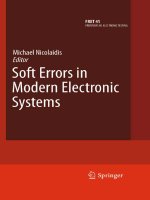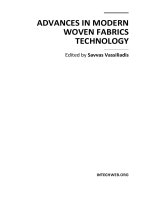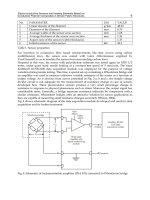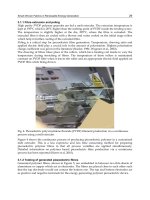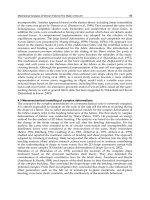Modern electronic structure theory, part 2
Bạn đang xem bản rút gọn của tài liệu. Xem và tải ngay bản đầy đủ của tài liệu tại đây (37.72 MB, 785 trang )
1
^
"
■
—
A d v a n c e d Series in Physical Chemistry - Vol. 2
EdfliiiaM
[qi.H CIJSEIJ C
»3iaTHiTUTH:
■ fJHjTrj /
Part II
Editor
UililU rl
filfiWliy
World Scientific
www.pdfgrip.com
MODERN
ELECTRONIC
STRUCTURE
THEORY
Part II
www.pdfgrip.com
Advanced Series in Physical Chemistry
Editor-in-Charge
Cheuk-Yiu Ng, Ames Laboratory USDOE, and Department of Chemistry,
Iowa State University, USA
Associate
Editors
Paul F. Barbara, Department of Chemistry, University of Minnesota, USA
Sylvia T. Ceyer, Department of Chemistry, Massachusetts Institute of
Technology, USA
Hai-Lung Dai, Department of Chemistry, University of Pennsylvania, USA
Benny Gerber, The Fritz Haber Research Center and Department of
Chemistry, The Hebrew University of Jerusalem, Israel, and
Department of Chemistry, University of California at Irvine, USA
James J. Valentini, Department of Chemistry, Columbia University, USA
Published:
Vol. 1: Physical Chemistry of Solids: Basic Principles of Symmetry and Stability
of Crystalline Solids
H. F. Franzen
Vol. 4: Molecular Dynamics and Spectroscopy by Stimulated Emission Pumping
eds. H.-L Dai and R. W. Field
Forthcoming:
Vol. 3: Progress and Problems in Atmospheric Chemistry
ed. J. R. Barker
Vol. 5: Laser Spectroscopy and Photochemistry on Metal Surfaces
eds. H.-L Dai and W. Ho
Vol. 6: The Chemical Dynamics and Kinetics of Small Radicals
eds. K. Liu and A. Wagner
Vol. 7: New Developments in Theoretical Studies of Proteins
ed. R. Fiber
www.pdfgrip.com
^\t^^^^fft^T»^tc^^tf^^^w^^B^j^^^cT[?M™^i^^^^^T^T^^^^^^KT^MP^r^^B
MODERN
ELECTRONIC
STRUCTURE
THEORY
Part II
Editor
David R Yarkony
Department of Chemistry
Johns Hopkins University
USA
World Scientific
Singapore • New Jersey • London • Hong Kong
www.pdfgrip.com
Published by
World Scientific Publishing Co. Pte. Ltd.
P O Box 128, Fairer Road, Singapore 9128
USA office: Suite IB, 1060 Main Street, River Edge, NJ 07661
UK office: 57 Shelton Street, Covent Garden, London WC2H 9HE
Library of Congress Cataloging-in-Publication Data
Modern electronic structure theory / editor, David R. Yarkony.
p.
cm. — (Advanced series in physical chemistry ; vol. 2)
Includes bibliographical references and index.
ISBN 9810213182 (hardcover: set) -- ISBN 9810221088 (pbk.: set) -ISBN 9810219598 (hardcover : pt. 1) -- ISBN 9810229879 (pbk : pt. 1) -ISBN 9810219601 (hardcover : pt. 2) -- ISBN 9810229887 (pbk. pt. 2)
1. Atomic theory. I. Yarkony, David. II. Series.
QD461.M5967 1995
541.2'8»dc20
94-43385
CIP
Copyright © 1995 by World Scientific Publishing Co. Pte. Ltd.
All rights reserved. This book, or parts thereof, may not be reproduced in anyform or by any means,
electronic or mechanical, including photocopying, recording or any information storage and
retrieval system now known or to be invented, without written permission from the Publisher.
For photocopying of material in this volume, please pay a copying fee through the Copyright
Clearance Center, Inc., 222 Rosewood Drive, Danvers, Massachusetts 01923, USA.
Printed in Singapore by Uto-Print
www.pdfgrip.com
A D V A N C E D SERIES IN PHYSICAL CHEMISTRY
INTRODUCTION
Many of us who are involved in teaching a special-topic graduate course
may have the experience that it is difficult to find suitable references, espe
cially reference materials put together in a suitable text format. Presently,
several excellent book series exist and they have served the scientific com
munity well in reviewing new developments in physical chemistry and chem
ical physics. However, these existing series publish mostly monographs con
sisting of review chapters of unrelated subjects. The modern development
of theoretical and experimental research has become highly specialized.
Even in a small subfield, experimental or theoretical, few reviewers are
capable of giving an in-depth review with good balance in various new de
velopments. A thorough and more useful review should consist of chapters
written by specialists covering all aspects of the field. This book series
is established with these needs in mind. That is, the goal of this series
is to publish selected graduate texts and stand-alone review monographs
with specific themes, focusing on modern topics and new developments in
experimental and theoretical physical chemistry. In review chapters, the
authors are encouraged to provide a section on future developments and
needs. We hope that the texts and review monographs of this series will
be more useful to new researchers about to enter the field. In order to
serve a wider graduate student body, the publisher is committed to making
available the monographs of the series in a paperbound version as well as
the normal hardcover copy.
Cheuk-Yiu Ng
V
www.pdfgrip.com
This page is intentionally left blank
www.pdfgrip.com
P R E F A C E GENERAL
GENERAL
PREFACE
Electronic structure theory, a key element in the rapidly changing field of
computational chemistry, uses quantum mechanics to describe, from first
principles, the behavior of chemical systems. The diversity of the systems
and the processes currently studied under the aegis of electronic structure
theory reflects the broad impact of chemistry in the physical and biological
sciences. In this two-part volume we describe from a practical perspective
the present state of electronic structure theory — its methods, their use,
range of applicability and impact — and provide perhaps a glimpse of how
and where the field is evolving.
Today's methodologies represent a marriage of formal theories and
modern computer architectures. What is tractable depends upon an under
standing of what needs to be described — the basic chemistry or physics
of the molecular interaction — and how best to achieve that description
— the algorithm. The contributors to this volume discuss both these as
pects of electronic structure theory in considerable detail. Equally impor
tant are contributions that address the impact of the field, describing how
electronic structure theory has contributed to our basic understanding of
chemical phenomena. Also addressed in this volume are the limitations
of the present state-of-the-art techniques, and directions that may in the
future eliminate those limitations.
Many of the contributions in this volume assume that all the electrons
are bound to the molecule and that the nuclei respond to the electronic
motion within the Born-Oppenheimer approximation. However, two con
tributions deal with electron scattering, considering processes in which
"external" electrons interact with "molecular" electrons. Other contribu
tions consider how to deal with the breakdown of the Born-Oppenheimer
approximation.
vii
www.pdfgrip.com
viii
Preface General
One point that will be eminently clear to the reader is that the field
is highly interactive. Developments in one aspect of computation or com
puter architecture drive developments in other areas. This has created a
vitality rare in a field that has now been in existence over 40 years. As a
consequence, there is no correct or linear order for reading this pedagogically oriented volume. This limitation is compensated for by the breadth
of the offerings over both parts of this volume, allowing the reader to find
most of the essential pieces of the puzzle within them.
David R. Yarkony
www.pdfgrip.com
PREFACE TO PART II
The eleven contributions contained in Part II address a broad range of
issues in electronic structure theory. One contribution deals with basis sets
and integrals (Chapter 12, by Helgaker and Taylor), the essential tools of
virtually all computational techniques considered in this volume, while a
second contribution deals with an alternative approach for treating those
integrals, the pseudospectral technique, and its potential impact on the cor
relation problem (Chapter 17, by Martinez and Carter). Methods aimed
at precise treatments of molecular structure and properties in small to
moderately sized molecules evince the breadth of the approaches to this
challenging and important problem. Two contributions explicitly discuss
multi-reference treatments: the time-dependent linear response approach
(Chapter 13, by Olsen and J0rgensen) and the time-independent quasidegenerate perturbation theory approach (Chapter 18, Hoffman). A third
contribution considers the coupled-cluster technique (Chapter 16, Bartlett).
This volume also includes a discussion of analytic gradient techniques em
phasizing their role in the calculation of vibrational properties (Chapter
19, Pulay). Two contributions illustrate how analysis of the computational
treatment contributes to assessing and improving the accuracy of an elec
tronic structure calculation. One such contribution considers composite
methods designed to determine bond energies to chemical accuracy (Chap
ter 14, by Raghavachari and Curtiss) and the second contribution considers
the chemistry of transition metals (Chapter 21, by Bauschlicher, Langhoff
and Partridge). An emerging technique for extending electronic structure
methods to very large molecular systems, density-functional theory (Chap
ter 15, Becke), is described. The impact of electronic structure techniques
in astrochemistry is discussed (Chapter 20, Kir by). Finally, an approach
to the electron scattering problem based on the Schwinger variational prin
ciple and its implementation in a massively parallel computer architecture
is presented (Chapter 22, by Winstead and McKoy).
David R. Yarkony
ix
www.pdfgrip.com
This page is intentionally left blank
www.pdfgrip.com
CONTENTS
Part I
Introduction
v
Preface General
vii
Preface to Part I
ix
1. The Chemical Applicability of Standard Methods in
Ab Initio Molecular Quantum Mechanics
Henry F. Schaefer III, J. Russell Thomas, Yukio Yamaguchi,
Bradley J. DeLeeuw and George Vacek
2. Multiconfigurational Second-Order Perturbation
Theory
Kerstin Andersson and Bjorn 0 . Roos
3. Direct Methods in Electronic Structure Theory
Jan Almlof
4. Ab Initio Calculation of Spin-Orbit Effects in
Molecules Including Electron Correlation
B. A. Hefi, C. M. Marian and S. D. Peyerimhoff
5. Theoretical Studies of Fullerenes
Gustavo E. Scuseria
3
55
110
152
279
6. Main Group Organometallic Chemistry: Bonding,
Structure and Reactivity
Mark S. Gordon
311
7. The Analytic Gradient Method for Configuration
Interaction Wave Functions
Ron Shepard
345
xi
www.pdfgrip.com
xii
Contents
Contents
8. Geometry Optimization on Potential Energy Surfaces
H. Bernhard Schlegel
9. The Incorporation of Modern Electronic Structure
Methods in Electron-Molecule Collision Problems:
Variational Calculations Using the Complex Kohn
Method
T. N. Rescigno, B. H. Lengsfield III and C. W. McCurdy
459
501
10. Exact Expansion Methods for Atomic Hydrogen in an
External Electrostatic Field: Divergent Perturbation
Series, Borel Summability, Semiclassical Approximation,
and Expansion of Photoionization Cross-Section over
Resonance Eigenvalues
589
Harris J. Silverstone
11. Electronic Structure Aspects of Nonadiabatic
Processes in Polyatomic Systems
David R. Yarkony
642
Index
1-1
Part II
Introduction
v
Preface General
vii
Preface to Part II
ix
12. Gaussian Basis Sets and Molecular Integrals
Trygve Helgaker and Peter R. Taylor
13. Time-Dependent Response Theory with Applications
to Self-Consistent Field and Multiconfigurational
Self-Consistent Field Wave Functions
Jeppe Olsen and Poul J0rgensen
14. Evaluation of Bond Energies to Chemical Accuracy
by Quantum Chemical Techniques
Krishnan Raghavachari and Larry A. Curtiss
725
857
991
www.pdfgrip.com
Contents
xiii
15. Exchange-Correlation Approximations in DensityFunctional Theory
Axel D. Becke
1022
16. Coupled-Cluster Theory: An Overview of Recent
Developments
Rodney J. Bartlett
1047
17. Pseudospectral Methods Applied to the Electron
Correlation Problem
Todd J. Martinez and Emily A. Carter
1132
18. Quasidegenerate Perturbation Theory Using
Effective Hamiltonians
Mark R. Hoffmann
1166
19. Analytical Derivative Techniques and the
Calculation of Vibrational Spectra
Peter Pulay
1191
20. Applications of Molecular Structure Methods to
Problems in Astrochemistry
Kate P. Kirby
1241
21. The Application of Ab Initio Electronic Structure
Calculations to Molecules Containing Transition
Metal Atoms
Charles W. Bauschlicher, Jr., Stephen R. Langhoff
and Harry Partridge
1280
22. Studies of Electron-Molecule Collisions on
Massively Parallel Computers
Carl Winstead and Vincent McKoy
1375
Index
1-1
www.pdfgrip.com
PART II
www.pdfgrip.com
This page is intentionally left blank
www.pdfgrip.com
C H A P T E R 12
G A U S S I A N BASIS SETS A N D MOLECULAR I N T E G R A L S
TYygve Helgaker
Department of Chemistry, University of Oslo
P.O. Box 1033, Blindern, N-0315 Oslo, Norway
Peter R. Taylor
San Diego Supercomputer Center
P.O. Box 85608, San Diego, California 92186-9784, USA
Contents
1. Introduction
2. Qualitative Considerations
2.1. Quantum Chemistry of Some Model Systems
2.2. Molecular Orbitals and Electron Correlation
2.3. Slater Orbitals and Gaussian Orbitals
2.4. Correlating Orbitals
3. Gaussian Basis Sets
3.1. Basis Set Convergence
3.2. Contracted Gaussians from Fits to STO's
3.3. Contracted Gaussians from Atomic Calculations
3.4. Segmented Versus General Contractions
3.5. Even-Tempered Sequences
3.6. Polarization Functions
3.7. Correlated Calculations
4. Basis Sets for SCF Calculations
4.1. Small Basis Sets
4.2. Larger Basis Sets
4.3. Extended Basis Sets
5. Basis Sets for Correlated Calculations
5.1. Nondynamical Correlation
725
727
728
728
731
734
737
741
741
743
744
748
750
752
753
753
755
757
759
760
760
www.pdfgrip.com
726
Modern Electronic Structure Theory
5.2. Small Basis Sets
5.3. Atomic Natural Orbitals
5.4. Correlation-Consistent Basis Sets
5.5. Basis Set Recommendations
6. Basis Sets and Molecular Properties
6.1. Basis Functions and Energy Derivatives
6.2. Spectroscopic Constants
6.3. Electric Properties
6.4. Magnetic Properties
6.5. Basis Set Recommendations
7. Basis Set Superposition Error
7.1. Counterpoise Correction
7.2. Basis Set Improvements and BSSE
8. Basis Sets: Miscellaneous Topics
8.1. Excited and Ionized States
8.2. Core Correlation
8.3. Bond Functions
9. Molecular Integrals — Introduction
10. Charge Distributions
10.1. Properties of GTO's
10.2. Hermite Gaussian Functions
10.3. Overlap Distributions
10.4. Overlap Distributions by Recursion
11. Simple One-Electron Integrals
11.1. Multipole Moments
11.2. Momentum and Kinetic Energy Integrals
12. Coulomb Integrals
12.1. Electrostatics for Gaussian Charge Distributions
12.2. The Incomplete Gamma Function
12.3. Hermite Integrals
12.4. Cartesian Integrals
12.5. The Obara-Saika Scheme
12.6. Integral Prescreening
13. Integrals over CGTO's
13.1. Cartesian Gaussian Integrals
13.2. Spherical Harmonic Gaussian Integrals
14. Property Integrals
14.1. Geometrical Derivative Integrals
14.2. Derivatives of London Orbitals
14.3. Spin-Orbit Integrals
15. Rys Quadrature
16. Molecular Symmetry and Integrals
16.1. Symmetry-Distinct Integrals over CGTO's
16.2. Symmetry-Adapted Basis Functions
762
764
768
770
771
771
774
775
779
782
783
784
785
787
787
787
789
790
792
792
793
796
799
800
801
804
805
806
809
815
819
821
828
829
829
832
833
833
837
839
840
842
843
845
www.pdfgrip.com
Gaussian Basis Sets and Molecular Integrals
16.3. Computational Implementations
16.4. Differentiated Integrals and Symmetry
17. Conclusions
Acknowledgments
References
727
727
847
849
849
850
850
1. Introduction
In this review, we shall be concerned with the use of one-electron ba
sis sets in quantum chemistry, and with the evaluation of integrals over
these basis sets. Our intentions are pedagogical — we hope to provide the
reader with the background material needed to choose suitable basis sets for
quantum chemical calculations and to understand how the integrals are
evaluated. We also hope to provide enough fundamental details for the
interested reader to pursue these topics in the current literature. We have
not tried to review the fields of Gaussian basis sets and integral evaluation
comprehensively, since this would require an entire volume (or more) to
itself.
The choice of the basis set is one of the most important factors in
designing reliable quantum chemical calculations, and deserves consider
able attention. We shall proceed by reviewing some qualitative analytical
features of wave functions, and how the analytical behavior is or is not re
flected by different types of basis function. A certain amount of historical
material about basis set development will be presented, but, as we have
said, we make no attempt at completeness here, since these matters have
been reviewed many times previously (see, for example, Refs. 1-3). We
shall concentrate on the design of accurate calculations in our discussion,
although recommendations for basis sets to be used at various levels of ac
curacy are included. The basis set requirements for calculating molecular
properties are also discussed.
In the second part of this chapter we consider various methods for
calculating integrals over the Gaussian basis functions that are invariably
the choice for modern quantum chemical calculations. Again, historical
material is presented without any claim to completeness — much of the
earlier literature in this subject is referenced in other reviews, and those of
Saunders 4 ' 5 are particularly recommended. We shall concentrate on devel-
www.pdfgrip.com
728
Modern Electronic Structure
Theory
opments of the last decade or so, and also on issues related to calculating
derivatives of the energy as well as the energy itself. We shall also touch
briefly on molecular property integrals and fine-structure integrals.
As a final introductory note, it is desirable to clarify some terminology.
Throughout this work, we employ the term "ab initio" to refer only to
nonempirical calculations based on wave functions. That is, our usage
excludes nonempirical density-functional-based methods that would have a
legitimate claim to be included under this rubric. This is in no sense a slight:
the latter methods are beyond the scope of this chapter and are nowhere
discussed, so it makes no sense to use a more restrictive construction than
ab initio when no ambiguity or confusion can occur.
2. Qualitative Considerations
The goal of a6 initio quantum chemical calculations is to predict the prop
erties of atoms and molecules using only the principles of quantum mechan
ics. Some insight into the problems encountered in trying to achieve this
goal can be obtained by considering several simple systems as illustrative
examples.
2.1. Quantum
Chemistry
of Some Model
Systems
Perhaps the simplest possible system is the hydrogen atom, for which the
Hamiltonian in atomic units takes5 the
i l i e iform
2
*=4v»-i.
tf == -- i v - ir.
(l)
H
(1)
r
2I
Here r is the electron-nucleus distance. The wave functions — solutions to
the wave equation
H*
HV =
= £tf
EV, ,
(2)
for different energy levels E of the hydrogen atom — are products of asso
ciated Laguerre functions6 in the radial coordinate and spherical harmonic
angular functions. Hence they involve an exponential radial dependence
exp(— r). A simpler set of functions displaying exponential radial depen
dence is given by
VW
r71""-1-- 11 e->
exp(-Cr),
JNr
(3)
where J\f is a normalization constant, n the "principal quantum number,"
and ( is the orbital exponent. The radial function Eq. (3) is commonly
www.pdfgrip.com
Gaussian Basis Sets and Molecular Integrals
Integrals
729
referred to as a Slater-type orbital (STO) or exponential-type orbital. The
ground state of the hydrogen atom is an STO with n = 1 and ( = 1.
The exponential form for the radial wave function is not surprising — the
Hamiltonian of Eq. (1) displays singular behavior as r -> 0, while the
exponential function shows a cusp behavior in this limit which cancels the
singular term. We note that the hydrogenic orbitals (solutions to Eq. (1))
form a complete set only if continuum solutions are admitted, as well as
bound-state solutions. 7 STO's, on the other hand, form a complete set when
only bound-state solutions are admitted.
Let us consider now a more complicated situation, the helium atom, in
which there are two electrons.
becomes
lectrom The
ne Hamiltonian
xiain tonian b<
_2_ >
2
1
22
r2
T\2
7*12
++ —
- i -H-ivi-A_l
vv ? - ^l
#=
J_,
^
T\l
rr *Ti2 ,
2
H = -
2
^
I
T\
(4)
(4)
where subscripts 1 and 2 have been used to label the electrons. The wave
equation involving this Hamiltonian can be regarded as intractable with
respect to analytical solution, and thus an alternative approach is required.
One strategy is to use a variational method, in which a trial wave function
\I>(a) involving adjustable parameters a is constructed, and the energy
functional
[<Z>*{a)HV{a)dT
f/
J
E(a) = J—
—f
* *tf*(a)$(a)dr
(a)*(a)dr
/[y*(a)V(a)dT
(5)
is made stationary with respect to variations of the parameters a. Assum
ing that the two electrons are spin-paired, we need to choose a trial wave
function that is symmetric in the coordinates of electrons 1 and 2. Clearly,
the hydrogen wave function suggests the desirability of exponential radial
behavior. However, there is now also a singularity in the Hamiltonian as
?*12 —► 0, which would imply cusp behavior in the wave function in this
limit. Hylleraas 8 suggested aa trial
form
trial function
function of
of the
the torn
c
2l
n r ))nn(r((ri
e x p (--[[nr i + rr22]]/2)
/ 22)Y,
) jY<
Y,rcmm(ri+r
mm(ri 2)+
{r122-'i 1n --r2r)2) r?r21 2,
(6)
(6)
nlm
nlm
nlm
where the coefficients c are to be determined variationally. The results from
optimization of trial functions of this type are excellent. Formal analysis
of the cusp as r\2 —► 0 shows that the wave function behaves as 1 + §7*12,
supporting the use of factors in r\2 like those in Eq. (6).
www.pdfgrip.com
730
Modern
Electronic
Structure
Theory
Somewhat more complication ensues if we introduce two nuclei into our
two-electron problem. The Hamiltonian for the hydrogen molecule at a
fixed internuclear
Luclear sej
separation is
11
l1 ^^ o
l1 ^„ o2 _ _L
2
H=V2|
H = - -2 V ? - -22 V
r
TAX
TAI
A
2
2
TAX
11
1_
TA2 i
TA2
TA2
1
1
^B\
TBI
TBI L
1
1
TBI
TBI
TB2
11
1
J_
11
44
■=—
4 —
T12
^12
RAB
\B •
^12
,-*
(7)
(7)
RAB
Here we have used RAB to denote the fixed internuclear distance which
appears in the (constant) nuclear repulsion energy. The reduction of the
symmetry of the system from spherical in the helium case to cylindrical for
H 2 introduces a number of complications. Nevertheless, by choosing to use
confocal elliptical coordinates,
{rAj 4
rBBi)
(fAi
4 TBi)
ct _ (TAJ
Bi) m.
—
S*
— ; »
Si —
p
RAB
K>AB
K>AB
-~ rTBi)
g Bij)
{TAJ ~
TBX)
_ {TAi
T
=
Vi —
r>
J
3
RAB
K>AB
K>AB
,ftx
(8)
we can expect good results from a trial wave function of the form
exp(-a[&
e x p ( -■<*[&+&
a[6 + 6]) E
Vitirfir&r?
hT\2 2 '.
(9)
(9)
ijklmm
Again, this approach is very successful,9 and only a few terms are needed
for high accuracy.
We should point out one subtlety concerning the exponential cusps at
the nuclei. These are a direct consequence of the assumption that the
nuclei are point particles like the electrons. This is an approximation, and
one that in relativistic calculations, for instance, is better dispensed with.
Once the nuclei are assumed to be finite in size, the electron-nuclear cusp
disappears.
In addition to the formal behavior of the wave function in the region of
the electron-nuclear and electron-electron cusps, much analysis has been
devoted to the asymptotic behavior (see, for example, Ref. 10). This is again
exponential in nature, for many-electron as well as one-electron systems.
In view of the foregoing discussion, the characteristics of a general
approach to molecular electronic structure appear clear. The molecular
nonrelativistic Coulomb Hamiltonian
(again -\with fixed nuclei — the
man (again
>us
Born-Opi
clamped-nucleus
Born-Oppenheimer
Hamiltonian)
)nian) is
ler Hamiltonia
-uppenneimei
impea-nucieus
Z
z2
BR
B AB'
tf^E^
EW
WA +++
"
^ E i ^ ++EE^^--i,AE
EE^*^*^ZAW
BA>B
R
i
i>j
i>j
i,A
A>B
do)
(10)
www.pdfgrip.com
Gaussian Basis Sets and Molecular Integrals
Integrals
731
To expand the unknown wave function, the foregoing analysis suggests that
trial functions that involve one- and two-particle functions should be con
structed: the former should display exponential behavior at the nuclei and
at long distances and the latter should behave linearly near zero in ri2Fermion statistics and spin symmetry must of course be properly incorpo
rated, but the desired analytical properties of the trial wave function are
those we have described. It might then come as a surprise to a reader with
mathematical inclinations and no experience of quantum chemistry that
such functions are in fact almost never used! Unfortunately, trial functions
of this very desirable type lead to almost unmanageable complications in
the wave function optimization. Such trial functions have been used rather
seldom, and then only for small systems with rather few electrons, be
cause of the very severe computational problems that arise from the manyelectron integrals that appear in the variational energy expression Eq. (5);
alternative strategies such as perturbation expansion of the wave function
and energy suffer from exactly the same problems. A compromise seems
necessary between mathematical desirability and computational feasibility:
that compromise is driven by the feasibility of evaluating and manipulat
ing the many-electron integrals that will appear when expressions such as
Eq. (5) are expanded. In order to understand how this compromise will
affect our computed results, we shall now broadly review the methodology
of ab initio molecular electronic structure theory.
2.2. Molecular
Orbitals
and Electron
Correlation
We can obtain some physical insight into the requirements for different trial
functions by partitioning the problem into different levels of treatment. As
a first approximation, we may assume that the detailed interaction between
electrons can be replaced by an averaged interaction potential: one in which
each electron interacts with a smeared-out charge distribution provided by
the other electrons. This is the mean-field or Hartree-Fock approximation.
It can be obtained by writing a trial wave function in which each electron oc
cupies a one-electron function termed an orbital:, the overall many-electron
wave function then takes the form
* = A(t/>i(n).--il>N(T
- 4 ( ^ i ( r i ) . . . ^ ( r Ni v)).) ) .
(11)
(11)
Here A is an antisymmetrizing operator designed to ensure that the overall
wave function obeys Fermi statistics (i.e., is antisymmetric with respect to
www.pdfgrip.com
732
Modern Electronic Structure
Theory
electron interchange). The functions tpi are the Hartree-Fock orbitals, T;
denotes the space and spin coordinates of electron i.
The Hartree-Fock orbitals are unknown functions of the electron coor
dinates. Their form may be determined by substituting the wave function
Eq. (11) into the variation principle and making the energy stationary. The
solution to the resulting Hartree-Fock equations then defines the optimum
orbitals. The form of the equations is given explicitly later in this section
and is also discussed in detail in the chapter by Almlof. For the present, we
mention only that for atoms and diatomic molecules, numerical methods
can be used to solve the Hartree-Fock equations to high accuracy, giv
ing numerical Hartree-Fock orbitals. However, for polyatomic molecules
no general convenient numerical method is available, and we proceed by
expanding the unknown Hartree-Fock orbitals in a fixed basis set,
z** ^ .
&
^ =2
XlL^lii •>
(12)
&
where the elements x^ of the basis set are chosen with an eye to computa
tional tractability and efficiency, and with some attention to the physics of
electronic motion.
It is obvious that the Hartree-Fock wave function is not a complete
representation of the electronic structure, because the true interaction be
tween electrons is not via an averaged potential, but is governed by the
Coulomb repulsion term in the Hamiltonian. In effect, the true electronic
motion will be correlated more than in the Hartree-Fock model, because
of the strong Coulomb repulsion that is exerted at small interelectronic
distances. Lowdin 11 coined the term "correlation energy" for the difference
between the exact nonrelativistic energy of a system and the Hartree-Fock
energy. At first sight, the correlation energy seems rather unimportant, be
cause it is a small fraction of the total energy. Indeed, for first-row atoms
and molecules the Hartree-Fock energy is typically more than 99% of the
total energy. However, the energy differences that are of interest in chem
istry, such as binding energies, are also only 1% or less of the total energy.
Hence we must not be surprised if the Hartree-Fock approximation is not
adequate for describing various phenomena of interest.
We can readily see that the explicit inclusion of interelectronic coordi
nates in the He and H 2 wave functions in Sec. 2.1 above is related directly
to the phenomenon of electron correlation. These functions provide a very
www.pdfgrip.com
Gaussian Basis Sets and Molecular Integrals
733
rapidly convergent representation, but, as we have stated, their use in more
general systems is accompanied by enormous computational complications.
Thus, we must find an alternative method of accounting for electron cor
relation. Let us suppose that a basis set has been used to approximate the
solution of the Hartree-Fock equations. In general, this set will include
more elements than there are occupied Hartree-Fock orbitals, and thus
there will be a complementary space of so-called virtual orbitals as well as
the occupied orbitals produced. iV-electron functions in which one or more
occupied orbitals are replaced by these virtual orbitals can be formed, and a
trial function can be constructed as a linear combination of these iV-electron
functions. This is the configuration interaction (CI) method. If a complete
basis set were used for the Hartree-Fock calculation, and all the possible
resulting iV-electron configurations were employed in the CI calculation,
our results would be exact. In practice, complete sets cannot be employed,
and then the results may be affected by the truncation of both the oneelectron basis set and, if additional truncation of the configuration space is
performed, by truncation of the iV-electron basis. We may expect that the
convergence of the correlation energy with truncation of the one-electron
basis will be slow. This is because the cusp behavior as an interelectronic
distance tends to zero is quintessential^ a two-electron phenomenon. Such
a two-electron cusp can be described rather well by only a few functions
that display cusp behavior themselves, as the results of Hylleraas 8 and of
James and Coolidge9 show. But if our two-electron functions can only
be represented using products of (in this sense, smooth) one-electron func
tions, a large number of such functions will be required. There is a contrast
here with representing the one-electron nuclear cusps, which as we saw can
be accurately described with exponentials. The correlation cusp inherently
will require long expansions in products of one-electron functions.
In practice, it is convenient to consider electron correlation as aris
ing from two different sources. What we have discussed so far — the
two-electron cusp behavior in the wave function — is termed dynamical
correlation, since its origins are in the dynamics of the electron motion.
In some circumstances, however, such as when chemical bonds are formed
or broken, the Hartree-Fock model itself is qualitatively incorrect. This
may be because other electron configurations are similar in energy to
the Hartree-Fock configuration, and interact strongly with it. Such nondynamical correlation is a failure of Hartree-Fock to provide appropriate
